
Alien Venus Flytraps | Otherworldly Hive-Mind Swamp Monsters
What seemed like a small meteor entering Earth’s atmosphere was actually an alien seed pod. It contained 4 pods and crashed into different ecosystems, including South Florida. Now, alien Venus flytraps rampage through the Everglades looking for humans to eat. Get the monster profile after the jump.
Latest News On Alien Venus Flytraps
Alien Venus Flytrap Background
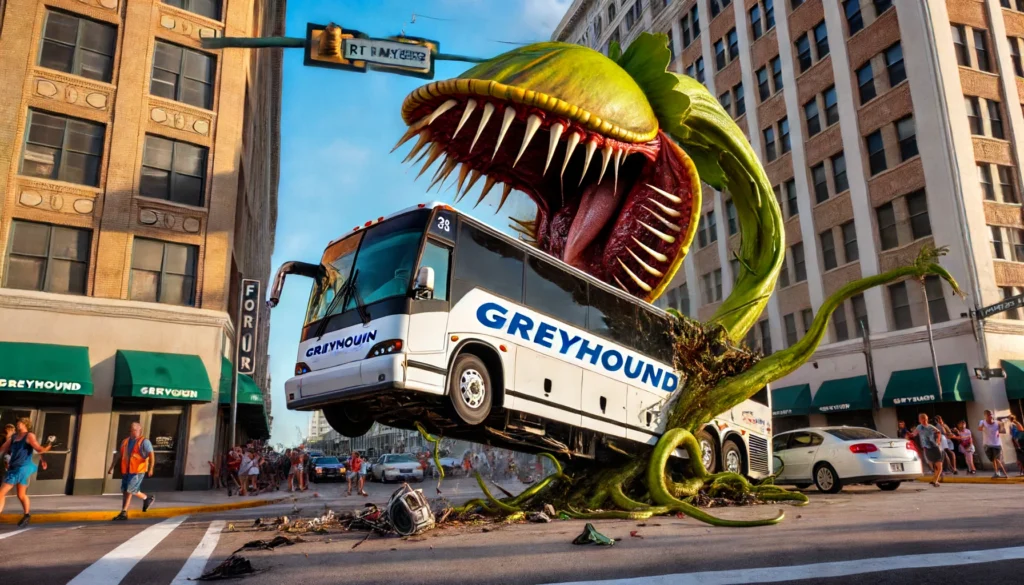
The monster in this profile superficially looks like a Venus flytrap, but it’s really an alien. The extraterrestrial species injected itself into common plants and transformed them by overwriting the plant’s DNA with the alien one. This causes the plants to mutate into those taking over the Everglades and Big Cypress parks.
Over 3 years ago, scientists believed a harmless meteorite crashed into the swamp. That meteor was actually an alien seed pod. Inside, an invasive alien species of plant escaped and merged with local flora to South Florida.
Clues to the invasion surfaced a year-and-a-half later as large mammals and reptiles began to vanish with no explanation. In actuality, it was the alien Venus flytraps feeding on them.
Physical Characteristics
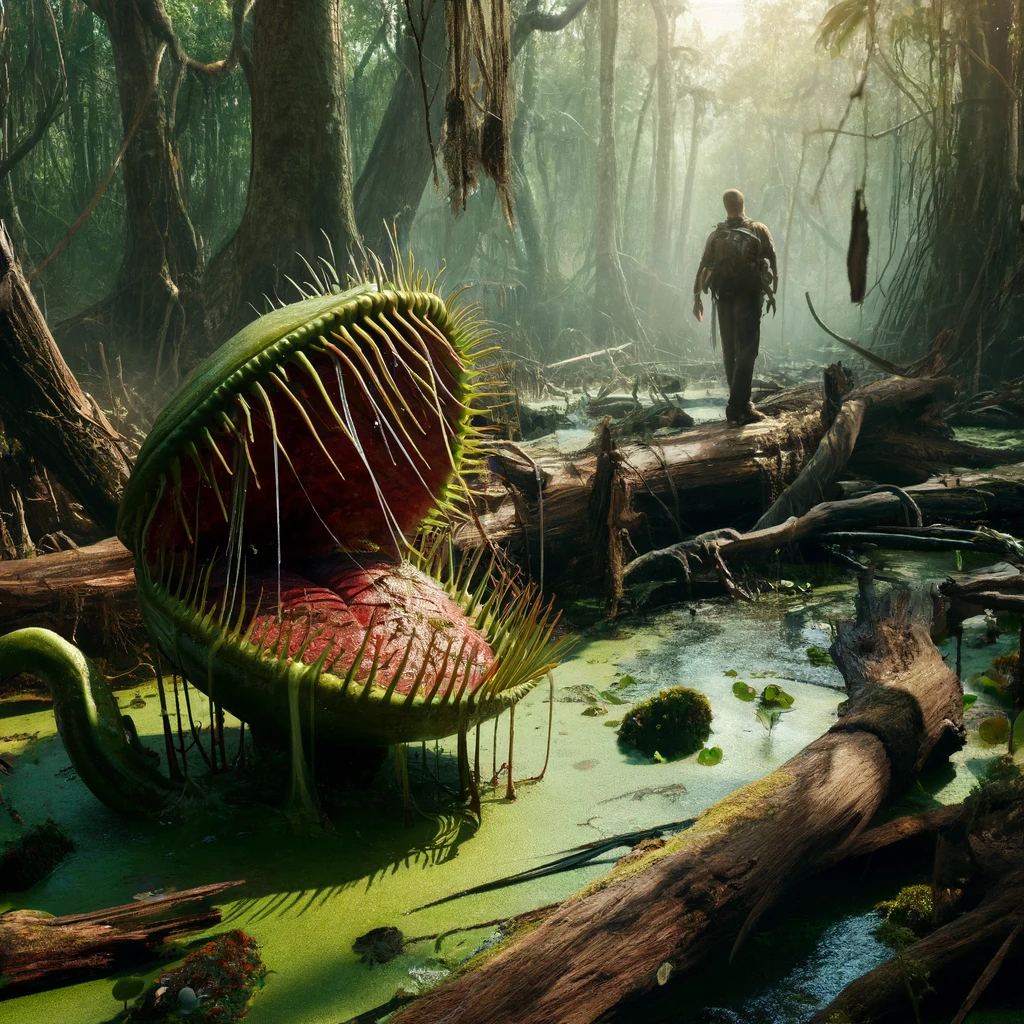
The alien Venus flytrap looks like a giant plant with some key differences:
- They can grow to monstrous size (over 30′ high has been reported)
- Their roots are tentacles they can use to entwine victims as well as slither around land or swim
- They secrete a neurotoxin in their mouths to paralyze prey for easier digestion
- A velcro-like surface on their tongues cause prey to stick to it to prevent escape
- Their teeth are as strong as iron bars to lock prey in their mouthes
- Alien Venus flytraps share a hive-mind with the seed pod that spawned them
- They can create bio-illuminant pods to digest large protein sources within their root-tentacles
Habitat and Ecology

Overall, the alien plant species is highly adaptive to its environment. In this case, the alien Venus flytraps adapted to the Everglades and Big Cypress parks in southern Florida. The factors it now favors include hot, swampy conditions; abundant food sources; little temperature variation; and, a lot of sunlight.
That would leave this alien subvariant with a much smaller range to spread over. Only the American Southeast and Gulf Coast would have suitable conditions. This means the flytraps wouldn’t be able to move north or west. It would be too cold and too dry for the alien species.
Behavior and Life Cycle

Alien Venus flytraps are carnivorous: They only eat meat, especially mammals. Some of their favorite prey includes:
- Humans (especially unsuspecting tourists)
- Panthers
- Deer
- Bobcats
- Raccoons
- Oppossums
- Foxes
- Dolphins
- Manatees
If starved for protein, an alien Venus trap will eat large reptiles like:
- Alligators
- Snakes (especially pythons and boa constrictors)
It’s not clear to how quickly the transmutation of local flora takes. Logically, it depends on the amount of protein, water and sunlight. The size of the plant may also extend the time as well as how the plant’s immune system fight the alien DNA restructuring. The plant will always succumb to the alien, but it may delay the transformation.
Researchers know that the oldest alien mutant plants have grown over 30′ high as seen in the Fort Myers mall attack. We can assume that means the flytraps can grow 10′ each year. There is no known upper-limit to the alien plant invaders’ height.
Special Abilities

The seed pod that brought the alien flytraps to earth allows for a complex, somewhat telepathic connection, that connects the seed pod and roaming flytraps in a hive-mind. Information can quickly flow back-and-forth and commands from seed pod travel lightning fast. Scientists also believe the seed pod and download a single monster’s knowledge and upload it into a new flytrap.
The beasts can also place humans and other large prey in pods to slowly digest them over a month. While this occurs, the alien monster can absorb the memories of the humans and transfer those memories to the hive-mind.
Alien Venus flytraps have an uncanny healing factor. They can take multiple shots and heal with minutes. These swamp monsters have taken grenades in their mouths and survived.
Impact on Human Activities
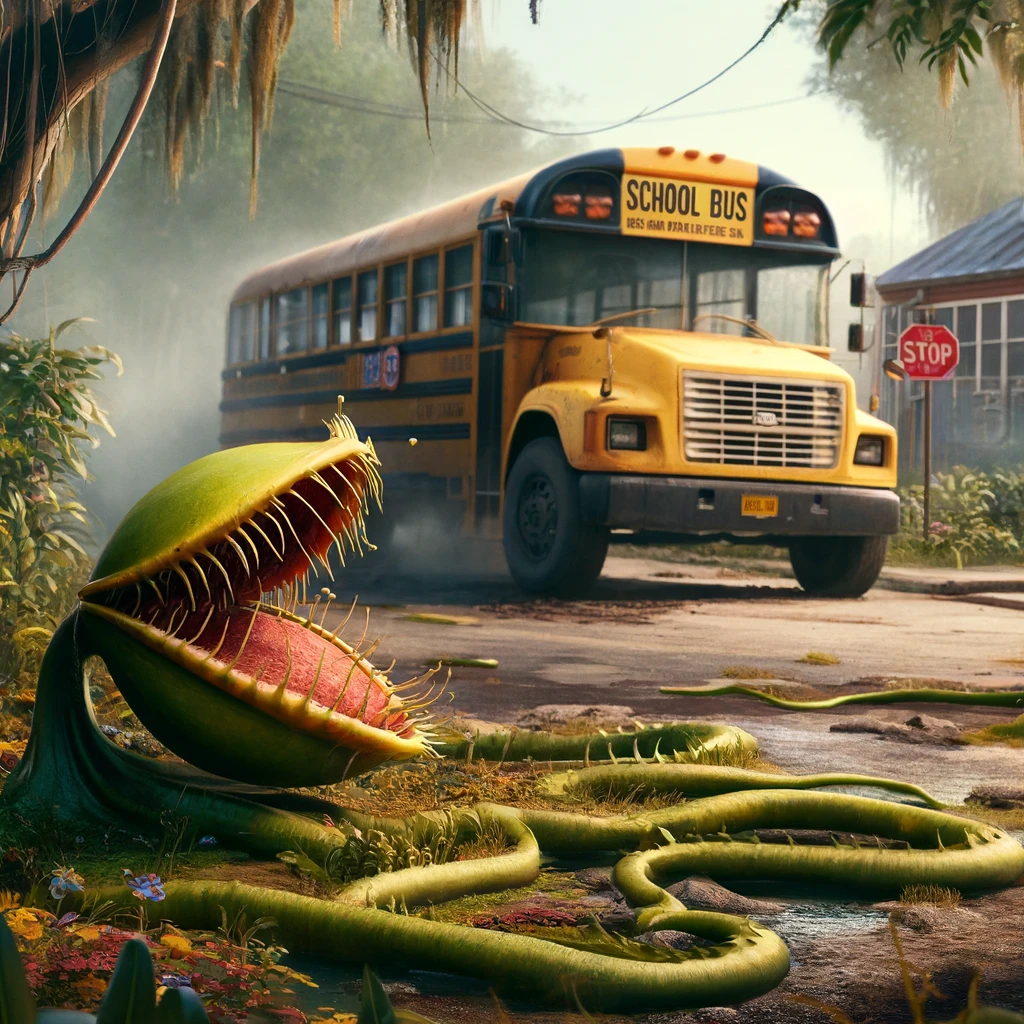
These swamp monsters have proven to be a threat to humanity and should be destroyed on sight. With their ability to transform local flora into monsters, they will quickly spread throughout the ecosystem, eating all mammals around it.
While their range is swampy environments in the American Southeast and Gulf Coast, scientists do not know if they will mutate to more a monster seeking more temperate environments. Only humanity can stop this monster from taking over.
And humanity is the alien Venus flytraps favorite prey.
Defense and Countermeasures

Until recently, most alien Venus flytraps stayed in the swampy waters of South Florida, but they attacked Fort Myers, Florida. This is likely due to starvation. As the swamp monsters grew, they need more and larger protein sources, and human cities have plenty of that. Cities routinely pump out excess water, but the plants used sewage systems and pipes to enter cities and towns.
Scientists have made one combat discovery, which works better than thought. Baking soda and vinegar, a commonly used weed prevention formula, seems to poison the flytraps. The military is currently making large quantities to combat the vicious alien Venus flytraps. However, the local flora ecosystem may not survive widespread bombing campaigns.
Scientific Research and Studies
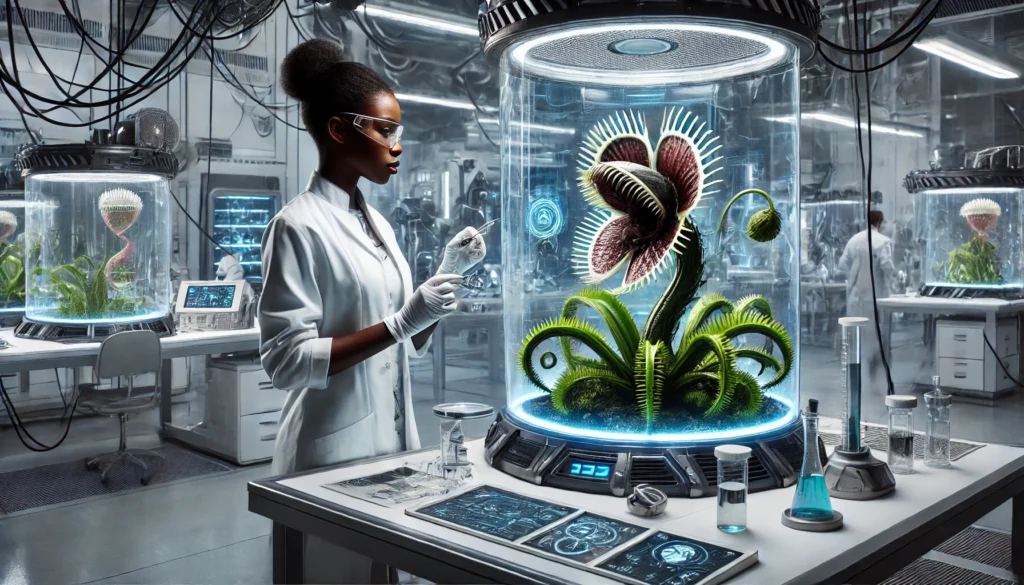
DNA sequencing and our understanding of viruses has helped scientists better understand the alien transformations. While researchers do not fully understand the aliens’ DNA, they have been able to see how it combines with DNA, and made a startling discovery.
Twenty percent of the new organisms’ DNA remains the earth plants’ genetic structure, which means it can be targeted. This earth-based DNA is well known and remains the foundation for the monsters adaptations to Earth.
Most chemical agents used to kill unwanted flora, like weeds, can work to slow the alien monsters down. Unfortunately, the world still suffers from supply chain issues with developing the large quantities needed to mount a successful attack.
Theoretical Origins and Evolution

It’s unknown where the alien seed pod came from. At first, NASA assumed it was a small meteor, no bigger than a Volkswagen Beetle, and posed no harm to Earth on impact.
That wasn’t the case.
As it entered the atmosphere, the pod’s encasing broke apart, and four smaller pods separated from it. Those crashed in Siberia, Bali, Florida and Antarctica.
Xeno-biologists and extraplanetary geographers believe it originated from one of the giant earth’s in nearby solar systems, but this is speculative.
Wherever it came from, the pod likely came from a large, rocky planet with ample liquid water and large animals. The Hubble telescope has been sent new instructions to scan for more objects like the pod, so Earth can try to destroy it before it enters our atmosphere.
Public Awareness and Education

Humans should remain vigilant for giant monster flytraps. These monsters have good camouflage and blend in well with swampy environments. Do not go looking for alien Venus flytraps. They may make interesting social media pictures and videos, but these swamp monsters will eat you. The aliens have already consumed a Greyhound bus full of tourists. They are not cute and cuddly monsters. They want to eat you.
You have been warned.
Future Outlook
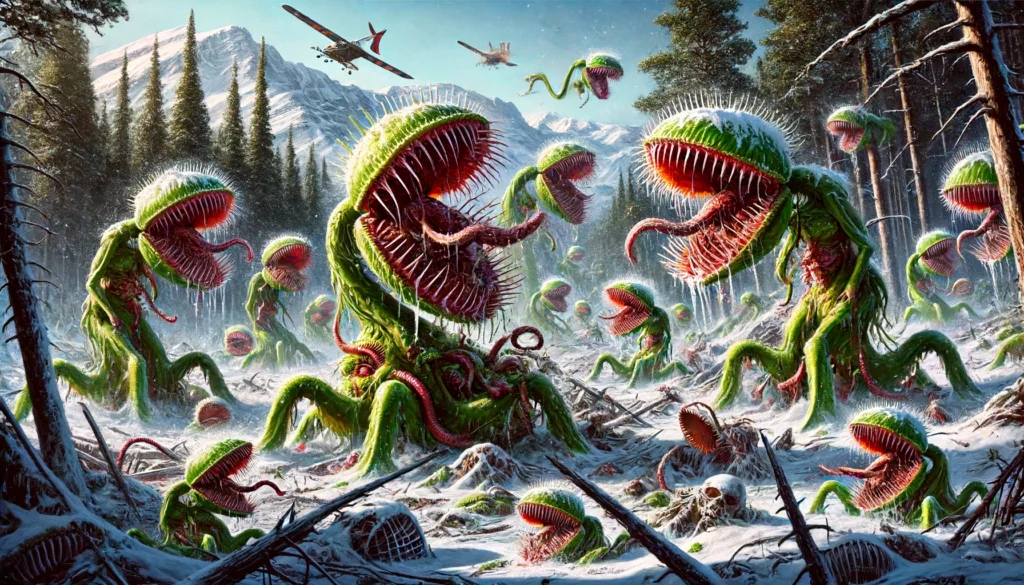
NASA detected 4 seed pods spreading across the globe. Scientists have found the Everglades pod and identified impacts in Siberia by Lake Baikal and Bali in Indonesia. The fourth one appears to have landed on Antarctica, near Argentina’s Brown Station. Research teams have left for these areas, and we’ve lost contact with all of them.
Currently, researchers investigate ways to deflect future pod strikes as well as introduce mRNA to undo the damage done to native flora. Engineers are also looking for ways to disrupt the hive-mind from a distance.
So far the most effective way to stop alien Venus flytraps has been baking soda and vinegar bombs, just like you’d use to stop weeds growing in your lawn.
Sources
While this article is fiction, I researched Venus flytraps and how they thrive in the real world, as well as the Everglades and viruses. Here’s the list:
“How to Grow a Venus Flytrap.” Better Homes & Gardens, www.bhg.com/gardening/houseplants/care/grow-venus-flytrap/. Accessed 3 June 2024.
“Venus Flytrap.” San Diego Zoo Wildlife Alliance, animals.sandiegozoo.org/plants/venus-flytrap. Accessed 3 June 2024.
“Growing Tips for Venus Flytraps.” Carnivorous Plant Nursery, carnivorousplantnursery.com/blogs/general-growing-and-care/growing-tips-for-venus-flytraps. Accessed 3 June 2024.
“Venus Flytrap.” South Carolina Aquarium, scaquarium.org/our-animals/venus-flytrap/. Accessed 3 June 2024.
Hodgson, Darren. “Venus Flytrap.” North Dakota State University, www.ndsu.edu/pubweb/chiwonlee/plsc211/student%20papers/articles02/dhodgson/dhodgson.html. Accessed 3 June 2024.
“Ultimate Guide: Animals of the Everglades.” Everglades Safari Park, www.evergladessafaripark.com/post/ultimate-guide-animals-of-the-everglades. Accessed 3 June 2024.
“Mammals – Everglades National Park.” National Park Service, www.nps.gov/ever/learn/nature/mammals.htm. Accessed 3 June 2024.
“12 Mammals in the Everglades.” Captain Jack’s Airboat Tours, www.captainjacksairboattours.com/12-mammals-in-the-everglades/. Accessed 3 June 2024.
“Mammals – Friends of the Everglades.” Friends of the Everglades, www.everglades.org/the-everglades-handbook/section-3-flora-and-fauna/mammals/. Accessed 3 June 2024.
“Everglades – Hidden Picture.” Exploringnature.org, www.exploringnature.org/db/view/Everglades-Hidden-Picture. Accessed 3 June 2024.
“Viral Manipulation of DNA Repair and Cell Cycle Checkpoints.” PMC, National Center for Biotechnology Information, 26 May 2009, www.ncbi.nlm.nih.gov/pmc/articles/PMC2725192/.
“Speed Read: Double-Checking Cells – NobelPrize.org.” NobelPrize.org, www.nobelprize.org/prizes/medicine/1996/speedread/.
Burdette, Dara. “Study Sheds Light on How Viruses Override Host Cell’s DNA Replication Machinery.” News Medical Life Sciences, 17 July 2023, www.news-medical.net/news/20230717/Study-sheds-light-on-how-viruses-override-host-cells-DNA-replication-machinery.aspx.
Chaurushiya, Mira S., and Matthew D. Weitzman. “Viral Manipulation of DNA Repair and Cell Cycle Checkpoints.” DNA Repair, vol. 8, no. 9, Sept. 2009, pp. 1087–1095, www.ncbi.nlm.nih.gov/pmc/articles/PMC2725192/.
Discover more from Ghosts & Monsters
Subscribe to get the latest posts sent to your email.